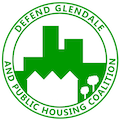Let’s compare what people’s rents would look like in public housing vs. AMI housing:
| Household Type | Monthly Income | Monthly Rent in Public Housing (30% of Monthly Income) | Monthly Rent in 30% AMI Housing |
| Senior on Social Security (1-bedroom unit) | $750 | $225 | $508 |
| Family of four earning MPHA’s “working household” average of $20,656 per year (3-bedroom unit) | $1,708 | $512 | $705 |
| Family of four earning MPHA’s average income of $14,201 per year (3-bedroom unit) | $1,183 | $355 | $705 |
| Family of four with no income (3- bedroom unit) | $0 | $75 (MPHA minimum rent) | $705 |
| Individual with no income (studio/efficiency) | $0 | $75 (MPHA minimum rent) | $474 |
https://www.hud.gov/topics/rental_assistance/phprog
It’s clear that public housing is a better option for low-income households.
What is AMI?
Area Median Income, or AMI, is the midpoint of all household incomes in a region, meaning half of all households earn more than the median income and the other half earn less. What counts as a “region” is determined by the U.S. Department of Housing and Urban Development (HUD), and for the Twin Cities it includes Minneapolis and St. Paulas well as dozens of white, wealthy suburbs – 13 counties in total. In 2017, the AMI for our metro area was $90,400. This number, which our public officials and institutions want to use to set affordable housing guidelines, groups the poorest residents together with the wealthiest residents, and wealthier white people together with low-income people of color. Click here for detailed information on AMI vs. Public Housing.
